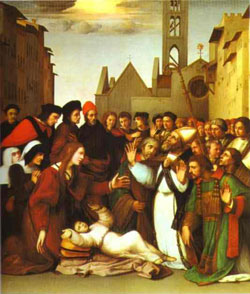
Feastday: May 25
Patron: of Florence
Birth: 337
Death: 417
Fact and fiction are intermingled in the traditional history of St. Zenobius, the principle patron of Florence, Italy. There are no contemporary records from which to reconstruct a reliable biography. A member of the Geronimo family of Florence, he is said to have been baptized at the age of twenty-one by Bishop Theodore, who afterwards ordained him and made him his archdeacon. The virtues and learning of Zenobius won him the friendship of St. Ambrose of Milan, by whose advice he was called to Rome by Pope St. Damasus. After carrying out successfully a mission from the Holy See to Constantinople, he returned to Italy. Upon the death of Theodore he was chosen Bishop of Florence, and edified all men by his eloquence, his miracles and the holy life he led with his deacon, St. Eugenius and his subdeacon, St. Crescentius. Five dead persons, we are told, were resuscitated by him, including a child who was run over by a cart as he played in front of the Cathedral. St. Zenobius died at the age of eighty and was buried at first in San Lorenzo and then in the Cathedral. Scenes from the life of St. Zenobius form the subject of many pictures by old masters in the Florentine galleries. His feast day is May 25th.
Shop Catholic - FREE Ship $60+
Face Masks Home Blessings Rosaries Bibles Medals Prayer/Holy Cards Pets Bracelets Pillow Cases Crucifixes Books Rosary Cases Wall Crosses Keychains Plaques Statues Rings Visor Clips Church GoodsSaint Zenobius (Italian: San Zanobi, Zenobio) (337–417) is venerated as the first bishop of Florence. His feast day is celebrated on May 25.
Life
 The Baptism of Saint Zenobius and His Appointment as a Bishop (Sandro Botticelli)
The Baptism of Saint Zenobius and His Appointment as a Bishop (Sandro Botticelli)
Born of a Florentine noble family, Zenobius was educated by his pagan parents. He came under the influence early of the bishop Theodore, was baptized by him, and succeeded, after much opposition, in bringing his father and mother to Christianity. He embraced the clerical state, and rapidly rose to the position of archdeacon, when his virtues and notable powers as a preacher made him known to Saint Ambrose, at whose instance Pope Damasus I (r. 366–386) called him to Rome, and employed him in various important missions, including a legation to Constantinople. On the death of Damasus he returned to his native city, where he resumed his apostolic labours, and on the death of the bishop of that see, Zenobius, to the great joy of the people, was appointed to succeed him. His deacons are venerated as Saint Eugene and Saint Crescentius. He evangelized Florence and its outskirts completely and combated Arianism.
According to his biographer and successor in the See of Florence, Antonius, he died in his ninetieth year, in 424; but, as Antonius says that Pope Innocent I (d. 417) was at the time pope, the date is uncertain.
There are grounds for believing that he actually died in 417, on 25 May, on which day the ancient tower where he is supposed to have lived, near the Ponte Vecchio, was annually decorated with flowers.
Veneration
His body was first buried in the Basilica di San Lorenzo di Firenze (consecrated by Saint Ambrose in 393), and was later translated to the church of Santa Maria del Fiore.
In the back of the middle of the three apses is the altar of Saint Zenobius. Its bronze shrine, designed around 1440, a masterpiece of Ghiberti, contains the urn with his relics. The central relief shows us one of his miracles, the reviving of a dead child. Above this shrine is the painting Last Supper by Giovanni Balducci. There was also a glass-paste mosaic panel The Bust of Saint Zanobius by the 16th century miniaturist Monte di Giovanni, but it is now on display in the Museo dell'Opera del Duomo.
Miracles
 The Last Miracle and Death of Saint Zenobius (Sandro Botticelli)
The Last Miracle and Death of Saint Zenobius (Sandro Botticelli)
Extraordinary miracles, including several instances of the restoration of the dead to life, are attributed to him. Zenobius is said to have resurrected several dead people. It is also said that after his death, a dead elm burst into life after his body touched it while being borne to the cathedral for burial.
A legend states that a child was once run over by a cart while playing. His mother, a widow, wailed as she brought the dead child to Zenobius' deacon. By means of a prayer, Saint Zenobius revived the child and restored him to his mother.
In art
Zenobius is often depicted with a dead child or man in his arms, or a flowering elm, both in reference to his miracles.
Sandro Botticelli depicted the life and work of Saint Zenobius in four paintings. In the first scene, Zenobius is shown twice: he rejects the bride that his parents intended him to take in marriage and walks thoughtfully away. The other episodes show the baptism of the young Zenobius and his mother, and on the right his ordination as bishop.
On the wall of the Palazzo Vecchio are frescoes by Domenico Ghirlandaio, painted in 1482. The apotheosis of Saint Zenobius was painted with a perspectival illusion of the background.
-

Domenico Veneziano, Saint Zenobius Performs a Miracle, 1445.
-
Wall fresco of Saint Zenobius in the Hall of Lilies (Sala dei Gigli), Palazzo Vecchio, Florence.
-

The Madonna with Saint Dominic (right) and Saint Zenobius (left), by Fra Angelico
-

Saint Zenobius seated with his deacons St. Crescentius and St. Eugenius kneeling at either side. Painting on a pillar in the Duomo Santa Maria del Fiore, Florence.
-

Saint Zenobius, façade of Santa Maria del Fiore, Florence
Notes
- ^ Stracke, Richard (2015-10-20). "Saint Zenobius: The Iconography". Christian Iconography.
- ^ Cathedral and Civic Ritual in Late Medieval and Renaissance Florence – Cambridge University Press










